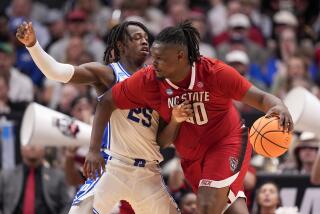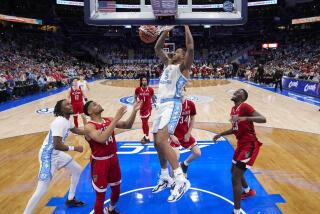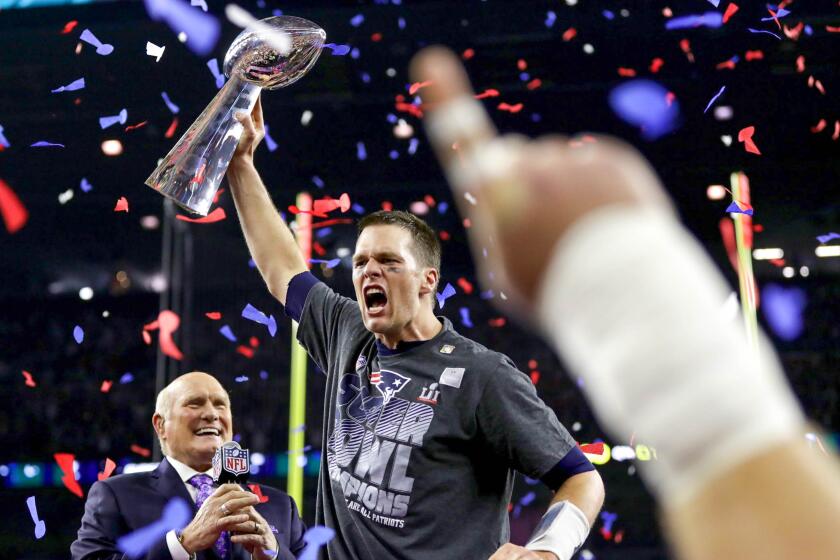Man Who Beat Chamberlain in NCAA Final Never Played Again
- Share via
For a variety of reasons, Joe Quigg was not the center of attention as North Carolina sought to complete a perfect season and win its first national basketball championship. He may have been the tallest player and the pivot man on the top-ranked team in the country but, both in size and stature, he was dwarfed by his Kansas rival. His own coach conceded as much by his choice of Tommy Kearns to contest the opening tap against Wilt Chamberlain.
Kearns, at 5-11, was the shortest starter on either team. But by promoting such a ludicrous physical mismatch, Frank McGuire hoped to seize the psychological initiative. For those in attendance at the Municipal Auditorium in Kansas City, it may have been the single most unforgettable sight in Final Four history.
The rest of us can only imagine. The networks had yet to discover college basketball in 1957. When North Carolina opposes Kansas in an NCAA Tournament semifinal at New Orleans on Saturday, there will be a crowd in excess of 60,000 at the Superdome and a national television audience in the tens of millions. By contrast, their first Final Four meeting 36 years ago--a historic and thrilling encounter that required three overtimes to decide--was witnessed by 10,000 spectators and Carolina residents fortunate enough to receive a black-and-white feed of the game. It seems to have been the only state in which the game was televised.
Nor was there much in the way of print coverage. Few newspapers outside the area of the competing teams staffed the game and only a handful of still photographers were seated around the court. Sports Illustrated, then in its third year, devoted a single page (and no picture) to the championship. Reminders are few.
“I have a copy of the newsreel,” Quigg recalled Monday from his dental office in Fayetteville, N.C., “that ran in the theaters.” Perhaps the most compelling, most theatrical game in tournament history is preserved in snippets on the late, lamented Movietone News.
Among those who have not forgotten is Chamberlain. In an interview telecast by ESPN on Sunday night, the man who would become the most prolific scorer and rebounder in pro basketball history asserted for the umpteenth time that the game was responsible for creating the public perception that he was a loser, one perpetuated by later playoff encounters against the Boston Celtics’ teams of Bill Russell. Carolina’s 54-53 victory, by the margin of Quigg’s two free throws, had other repercussions. “It started (big-time) basketball in the South,” the man said.
Ironically, the coach and all five Carolina starters were Yankees. McGuire had moved to Chapel Hill after coaching at his alma mater, St. John’s. He continued to recruit in the old neighborhoods. Lennie Rosenbluth was the first big catch. Quigg, the 6-9 center from St. Francis Prep, was the next to sign. He was followed by Kearns, Pete Brennan and Bob Cunningham.
“The reason was Frank,” Quigg said. “It was right after the scandals and New York basketball had disappeared. Everyone was going out of town to play.” The dapper McGuire convinced enough skilled New Yorkers to come on down that, in four years’ time, Carolina soared to the top of the national polls and overcame Michigan State in the semifinals, also in three overtimes.
So formidable was Chamberlain’s presence that Kansas (24-2) was favored to win even though the Tar Heels were undefeated in 31 games and better manned at every position save one. Where the 7-foot sophomore was concerned, however, one against five was excellent odds. “A colossus,” Quigg called him after watching some of Kansas’ 80-56 semifinal demolition of San Francisco.
By hitting two early shots from the corner, however, Quigg foiled the Jayhawks’ strategy of playing a box-and-one to shut down Rosenbluth. Chamberlain was lured outside and Carolina’s leading scorer took advantage, pushing the Tar Heels to a 29-22 lead. Kansas came back to go ahead in the second half but Kearns tied the score on a free throw with seconds left in regulation.
Although Rosenbluth had fouled out, Carolina hung in through two extra sessions. With his team trailing by a single point and time running out, Quigg pump-faked and drove on Wilt. His shot didn’t fall but Maurice King was whistled for a reach-in foul. Six seconds remained.
McGuire immediately called a timeout. He wasn’t concerned as much about the poise of his center as he was in setting his defense. Nevertheless, Quigg walked over to the man and said, “Don’t worry, coach, I’m going to make them.”
Quigg had missed his only previous free throw of the night but he was a 72% shooter during the season, second best among Carolina starters. “I knew I was going to make them,” he recalled. “I felt great. I felt that way the whole game.”
He sank both for his ninth and 10th points. Chamberlain scored 23 points and accounted for half his team’s 28 rebounds, yet suffered for the sins of his team. The other Kansas players combined to shoot nine of 34.
That last free throw, the one that made such an impression on the sport, would be the final point of Quigg’s basketball career. Although he had another year of college eligibility, he broke his leg in preseason practice the following fall. The New York Knicks still selected him in the second round of the 1958 NBA draft and signed him to a contract for the munificent sum of $7,500, but the leg did not recover sufficiently.
Quigg took the money and invested it in dental school. “I often wonder if I would have stayed in Carolina if I had missed those shots,” he said.
Chamberlain, of course, had a lot of shots left. Five years later, he amassed 100 points for the Philadelphia Warriors in a game against the Knicks. His coach was named Frank McGuire.
More to Read
Go beyond the scoreboard
Get the latest on L.A.'s teams in the daily Sports Report newsletter.
You may occasionally receive promotional content from the Los Angeles Times.










